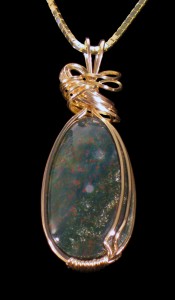- NEW DVD Series – Stone Setting with Bezels
- Tube Set Charm by Kim St. Jean
- Prong Basket Pendant by Kim St. Jean
- NEW DVD Series – Stone Setting with Cold Connections
- New DVD Series – Stone Setting with Wire
- NEW DVD Series: Introduction to Stone Setting by Kim St. Jean
- Featured Tool: Bracelet Bending Plier
- NEW Dvd by Eva Sherman
- Fun, Fast Fold Forming DVD Series
- Double Band Ear Cuff from Alex Simkin
Gem Profile May 4: Orbicular Agate and Botryoidal Agate
by Rose Marion, Wire-Sculpture.com

Orbicular Agate, one in a Series on Quartz
Shop Agate Cabochons | Shop Agate Beads
In today’s agate article we will discover orbicular agate, bloodstone, and botryoidal agate. I apologize for the lack of pictures; these are some rare forms of agate. Instead, I have included several links so you can visit several rockhounds’ private collections of these unique agates. Please enjoy!
Bloodstone is often categorized with jasper because of its opacity, but it is actually more like a moss agate (which will be covered in a future article) with green and hematite specks. Bloodstone can also be more translucent, which is when it is categorized with agate. As Dale mentioned in her article on Bloodstone, "the type of bloodstone that is considered to be a gem-"stone" is a high-quality, translucent, rich green with many well distributed bright red splashes."
Orbicular Agate: As shown with bloodstone, the components that make up rocks and gems have quite a bit of overlap between agate and jasper, including the orbicular varieties. As you may remember from Dale’s jasper discussion, the kinds of jasper that have circles or spherical inclusions – "needle-like crystals of different minerals in a radial structure" – are called orbicular jasper, such as ocean jasper and Dalmatian jasper. However, that is practically a synonym of orbicular agate. But – what are the types of round-spotted agate?
Polka dot agate has round spots on a translucent background in a variety of colors, such as blue, brown, yellow, gray, and green, as you can see in this example. It can be found in several locations, Oregon being one of the well-known US locations, yielding slabs like these.
Pigeon blood agate is named for its bright red hue from the high iron content of the stone; pigeon blood agate is often clear with a few bright red spots, while others have many red inclusions and a translucent background. This agate is found in Utah. You can understand the bloody connection by taking a peek at this pigeon blood agate and the cabochons on this page.
A little different from orbicular agate is botryoidal agate, also called grape agate. "Botryoidal" comes from the Greek term for a "bunch of grapes." This type of agate really does look like a bunch of grapes: spheres form in the layers, rather than flat or banded layers. These bubble-like structures can be on the surface, which looks like a pot of boiling water frozen in time. Click here to see some colorful examples of botryoidal agate. The grape- or bubble-like structures can also form away from the surface, into the stone, called turtlebacking: here is an example of a turtleback blue agate cabochon. What an interesting effect! This adds a deep dimension to the cabochons. Several other minerals can present in a botryoidal or globular shape, including fluorite, hematite, and malachite.
What causes the botryoidal feature? From its Wikipedia entry, "Each sphere (grape) in a botryoidal mineral is smaller than that of a reniform mineral, and much smaller than that of a mamillary mineral. Botryoidal minerals form when many nearby nuclei, specks of sand, dust, or other particles, are present. Layers of mineral material are deposited radially around the nuclei. As more material is deposited, the spheres grow larger and eventually overlap with those that are nearby. These nearby spheres are then fused together to form the botryoidal cluster."
Next week’s article will cover fire agate and iris agate – I can’t wait! Have you made wire jewelry with fire agate or iris agate? Send your agate pictures to tips@wire-sculpture.com, and they could be featured!
Resources
- https://en.wikipedia.org/wiki/Botryoidal
- https://mindat.org
- https://www.glypticconcepts.com/turtleback.html
- Peterson Field Guide to Rocks and Minerals by Frederick H. Pough, ISBN 0-395-91096-X
Gem Profile by Rose Marion
Click to Receive Daily Tips by Email





















Margaret Lakas
May 7, 2012 at 6:29 pm
Incredible colors. Vicky did a beautiful wrapping job, very nice. Thanks for the interesting info.
Pingback: Fire Agate and Iris Agate Gem Profile | Jewelry Making Blog | Information | Education | Videos